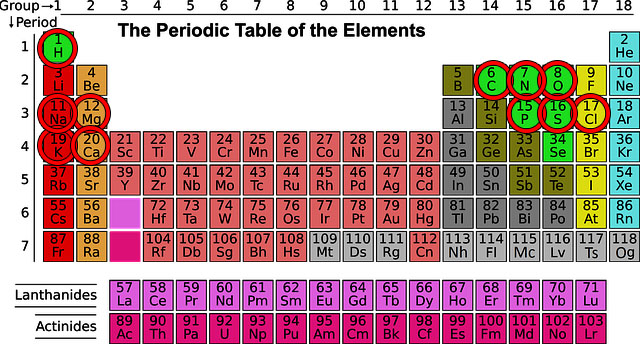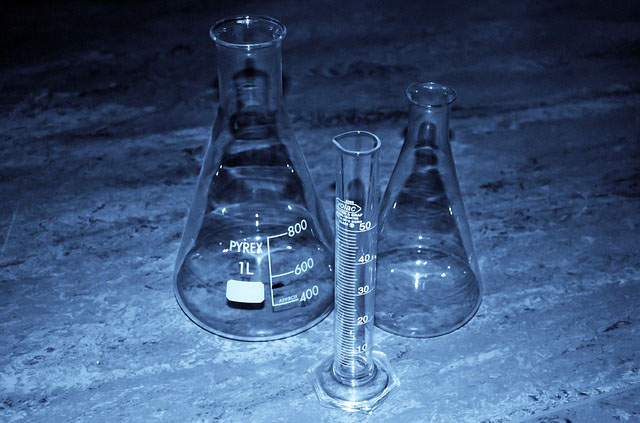The first synthetic urine was made in the lab by scientists who wanted the cleanest possible urine. The reason: They needed a perfect urine specimen to calibrate their devices for measuring specific gravity, pH values, uric acid values and so on.
In short, before we all started using it for passing a drug test, synthetic urine was invented as a benchmark for medical urine testing.
What was in fake urine? The composition of synthetic urine was much simpler than it is today. It involved dissolving urine-specific molecules such as uric acid and urea to get the right pH levels, and sulfate salts like potassium sulfate (K2SO4) to bring the specific gravity up in the 1.000-1.035 range.

The mixture of chemical that synthetic urine is made out of today is much more diverse and the quantity of each chemical is much more important. This is because drug testing labs are always desperately trying to detect synthetic urine, but the best synthetic urine mixtures are always two steps ahead.
Let’s have a look at what ingredients you should put into a vial to make synthetic urine. In the end, you will theoretically be able to make synthetic urine in your garage DIY-style (but I would refer of putting anybody’s carrier on the line by using DIY synthetic urine).
Ingredients That Synthetic Urine Is Made Out Of
As you can imagine, pretty much every synthetic urine provider keeps their specific synthetic pee mixture in a safe. Nonetheless, we can reasonably assume what chemicals and how much of them there is in synthetic urine by:
- Checking the ingredient list of the best synthetic urine – the Sub Solution (we’ll use this to identify all the chemicals that go into making synthetic urine).
- Calculating how much of which synthetic urine ingredient we need to use to nail down appropriate pH levels and specific gravity.
When answering what is the synthetic urine made of, we always have to start with the 3 main ingredients that should be found in any synthetic urine (one of the cheaper brands didn’t use one of the main ingredients for a while, and the results were not good, to say the least):
3 Main Ingredients – Urea, Uric Acid, Creatinine
This first thing every lab does to authenticate that the urine is real is check levels of urea, uric acid, and creatinine in the urine sample. This is because every natural urine contains those three ingredients, and thus it’s imperative that synthetic urine contains them as well, and in the same quantity.
If you’re trying to make 3.5 oz of synthetic urine at home in a vial, be sure to include:
- Urea: the concentration should be 50-100 mg/dl. For 3.5 oz urine, you should add 50-100 mg of urea.
- Uric acid: the concentration should be 5.0-7.0 mg/dl. Add 5-7 mg of powdered uric acid.
- Creatinine: the concentration should be 35-320 mg/dl. Add 35-320 mg of creatinine.
Now, you see there is a range – for example, urea concentration should be between 50 and 100 mg/dl. The whole point of best synthetic urine brands is to nail that number down as narrowly as possible.
There is a biological variability when it comes to these concentrations; everyone’s urine is special in a way.
When making your own urine, you just have to, well, kind of do the guesswork yourself because you don’t have sophisticated analytical measurement devices the synthetic urine producers have to safeguard addition of every ingredient.
6 Supporting Ingredients – Ionic Salts That Bring Specific Gravity Up
You should bring out your Periodic Table for this section. Our urine contains a number of salts that make it taste salty (if you don’t want to taste your own pee just ask Bear Grylls for confirmation).
Therefore the mixture the synthetic urine is made out of must contain these same salts. Here is the full list of 6 ionic sals and a rough estimate on how much should be added if you’re making a 3.5 oz of synthetic urine:
- Potassium sulfate (K2SO4): Add 100-300 mg.
- Sodium sulfate (Na2SO4): Add 100-300 mg.
- Ammonium phosphate ((NH4)3PO4): Add 50-150 mg.
- Ammonium diphospate ((NH4)6(PO4)2): Add 50-150 mg.
- Calcium chloride (CaCl2): Add 10-50 mg.
- Magnesium chloride (MgCl2): Add 25-100 mg.
Again, it’s really difficult to pinpoint just how much of let’s say potassium sulfate goes in the synthetic urine – it can be as little as 100 mg or as much as 300 mg. That’s why making synthetic urine yourself is tricky.
From the table of the chemical composition above you can see that synthetic urine contains both ammonium salts and uric acid, right? Well, if you’ve ever wondered if synthetic urine smells of urine, here is your answer. It does, and the odorous ammonia and uric acid are the reason for it.
How To Make Synthetic Urine Yourself?
Well, for of all, you can make it yourself and even analyze it but don’t bring it to a drug test with you. You’re much better of leaving the production and analysis of synthetic urine to the experts.
For DIY synthetic urine, you will need the following:
- Volumetric flash that holds at least 10 oz. (15 oz. is perfect).
- The chemicals stated above – getting them in 100% pure is tricky, a specialized shop for chemicals might have them.
- pH meter. The simplest one with paper indicators will do.
- A scale. To measure specific gravity.

The procedure for making synthetic urine is quite simple:
- Weigh the empty volumetric flash and write the weight down (mass1)
- Weigh the right amount of all the ingredients – urea, uric acid, creatinine, ionic salts – and add them to a volumetric flask.
- Add water up to 3.5 oz line and mix everything well. You should be looking at a yellow-colored solution we call synthetic urine. Now we need to validate it by testing pH and specific gravity.
- Measure the pH of the DIY synthetic urine with a pH meter. pH should be anywhere from 4 to 10; the ideal target pH is between 5.5 and 8.
- Weigh the volumetric flask with the DIY synthetic urine and write the weight down (mass2)
We have to confirm that the specific gravity of DIY synthetic urine is between 1.000 and 1.035. We will use the equation for specific gravity, which is as follows:
Specific gravity = (mass2 – mass1) / (volume)
The mass2 – mass1 is the total mass of created synthetic urine, let’s express it in grams – should come up to something like 105 g.
The volume is the volume of created synthetic urine. We already know it’s 3.5 oz; we need to transform 3.5 oz into milliliters. 3.5 oz = 103.5 ml.
To get the specific gravity of synthetic urine, we divide the mass with volume. For example, if the mass is 105 g and volume is 103.5 ml, the specific gravity is 1.0145.
That falls between the 1.000 and 1.035 specific gravity; that’s a good indication as any that we have made valid synthetic urine.
